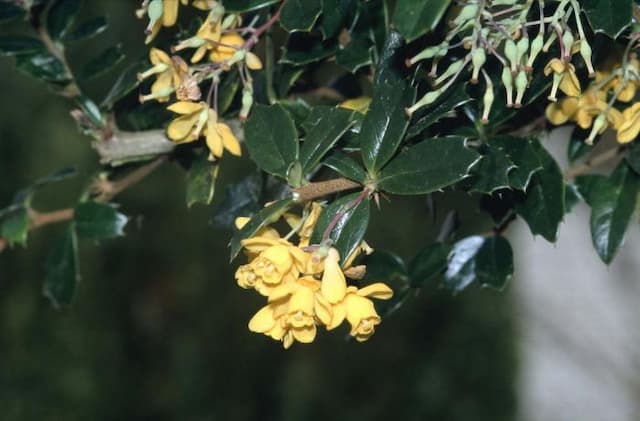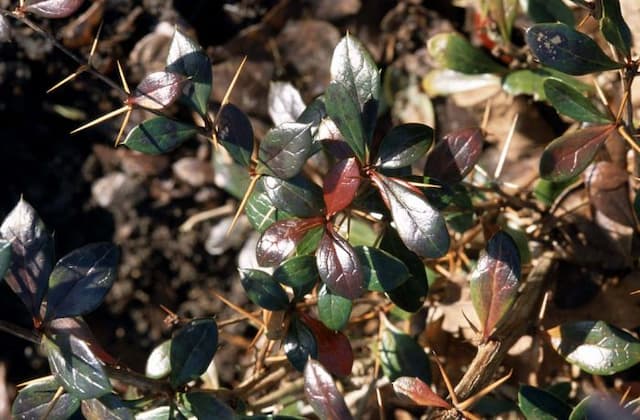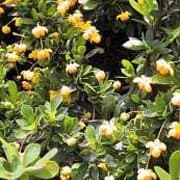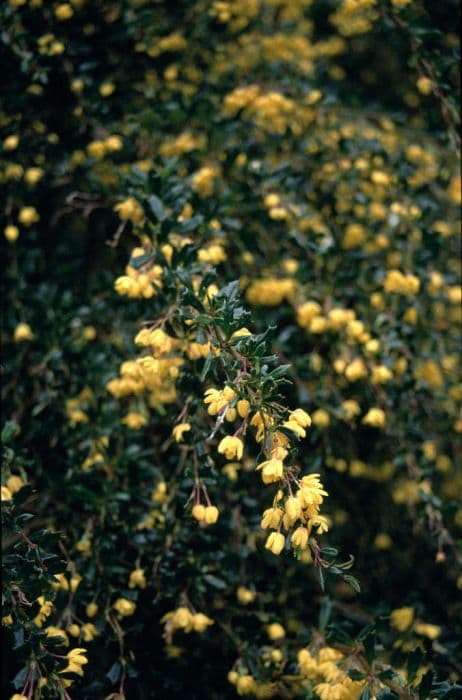Ottawa Barberry Berberis × ottawensis f. purpurea 'Superba'

ABOUT
The plant commonly known as the Ottawa Superba barberry boasts striking foliage and an attractive overall form that makes it a popular choice for gardeners seeking a vibrant and textured addition to their landscapes. The leaves are a deep purple hue, adding a splash of rich color that contrasts beautifully with the green tones commonly found in garden settings. As the seasons transition from spring to autumn, the purple leaves may shift to a brighter red, providing a dynamic and visually appealing change that enhances its decorative appeal. Bearing small, clustered flowers that are a subtle shade of yellow, this barberry adds a delicate floral touch in the springtime. These blooms may not be the most prominent feature of the plant due to their size, but they contribute an understated elegance to its overall aesthetic. Following the flowers, the plant produces tiny, berry-like fruits that bring additional visual interest. The fruits are often a bright red, offering further ornamental value and attracting the attention of birds and other wildlife to the garden. For those looking to add a sense of structure to their landscape design, the Ottawa Superba barberry is an excellent choice. Its growth habit forms a natural, densely-branched structure with an appealing shrubbiness that works well as a stand-alone feature or when incorporated into hedges or border plantings. The thorns dotted along the branches provide a natural deterrent for animals, making it a practical as well as a picturesque addition to a garden. In conclusion, the Ottawa Superba barberry is a robust and aesthetically pleasing plant with a bold leaf color, seasonal interest, and versatile landscaping potential. Its color and structure make it a favored choice for anyone looking to introduce a low-maintenance yet striking element to their outdoor space.
About this plant
 Names
NamesFamily
Berberidaceae
Synonyms
Ottawa Barberry, Superba Barberry, Purple-leaved Barberry
Common names
Berberis × ottawensis f. purpurea 'Superba'.
 Toxicity
ToxicityTo humans
The plant commonly known as Purpleleaf Barberry is not highly toxic to humans. However, like many plants, it may cause mild stomach upset if ingested, and the thorns can cause physical injury if not handled properly.
To pets
The Purpleleaf Barberry plant is also not highly toxic to pets. Similar to its effects on humans, this plant could potentially cause gastrointestinal upset if ingested in large quantities by pets, and its thorns could also injure pets if they try to chew on the branches or foliage.
 Characteristics
CharacteristicsLife cycle
Perennials
Foliage type
Deciduous
Color of leaves
Purple
Flower color
Yellow
Height
6 feet (1.83 meters)
Spread
6 feet (1.83 meters)
Plant type
Shrub
Hardiness zones
4
Native area
Cultivar
Benefits
 General Benefits
General Benefits- Ornamental Appeal: Adds aesthetic value to gardens with its rich purple foliage and yellow flowers.
- Privacy Screening: Dense growth habit makes it ideal for creating hedges and privacy screens.
- Erosion Control: Its root system helps stabilize slopes and prevent soil erosion.
- Wildlife Attraction: Yellow flowers and berries attract birds and pollinators to the garden.
- Low Maintenance: Requires minimal care once established, making it suitable for low-maintenance landscapes.
- Tolerance to Conditions: Adapts well to a range of soil types and can tolerate urban pollution.
- Seasonal Interest: Offers year-round interest with changing leaf colors and persistent winter berries.
- Barrier Planting: Thorns provide a natural barrier against unwanted foot traffic and animals.
 Medical Properties
Medical PropertiesThis plant is not used for medical purposes.
 Air-purifying Qualities
Air-purifying QualitiesThis plant is not specifically known for air purifying qualities.
 Other Uses
Other Uses- Photography Backdrop: The deep purple foliage and striking form make Ottawa barberry a popular choice for photographers looking for a rich, colored backdrop in garden photography.
- Natural Fabric Dyes: The colorful leaves and berries can be used to create natural dyes for fabric, imbuing them with shades of yellow, green, or dark blue depending on the mordant used.
- Artistic Inspiration: Artists may use Ottawa barberry for its aesthetic value as inspiration for paintings, drawings, or sculptures.
- Bonsai: With its attractive foliage and ability to withstand pruning, Ottawa barberry is a suitable plant for the art of bonsai.
- Culinary Garnish: Although not commonly consumed, the vibrant foliage can be used as a decorative garnish for plating dishes in high-end culinary presentations.
- Wildlife Shelter: Its dense thorny thickets provide excellent shelter and protection for small birds and other wildlife within a garden setting.
- Privacy Screening: When planted in rows or hedges, Ottawa barberry can act as a living privacy screen due to its dense and thorny nature.
- Erosion Control: The robust root system of Ottawa barberry helps stabilize soil and prevent erosion on slopes or in areas prone to degradation.
- Traditional Crafts: The wood of Ottawa barberry, though not commonly used, could be incorporated into traditional crafts or woodworking projects.
- Seasonal Decorations: Branches laden with berries can be cut and used in fall and winter decorations, wreaths, and floral arrangements.
Interesting Facts
 Feng Shui
Feng ShuiThe Purpleleaf Barberry is not used in Feng Shui practice.
 Zodiac Sign Compitability
Zodiac Sign CompitabilityThe Purpleleaf Barberry is not used in astrology practice.
 Plant Symbolism
Plant Symbolism- Protection: Barberry, in general, has thorns which have led to its association with protection as it can act as a natural barrier.
- Sharpness: The pointed thorns also symbolize sharpness or precision, possibly referencing sharp wit or intellect.
- Adaptability: Since the 'Superba' cultivar is a hybrid, it represents adaptability and the ability to thrive in diverse conditions.
- Balance: This plant's maroon-purple leaves might symbolize balance, intermingling its vibrant color with the traditional green of nature.
 Water
WaterThe Ottawa Barberry should be watered deeply to encourage a strong root system, typically around 1-2 inches of water per week, depending on climate and soil conditions. It's important to allow the soil to dry out between waterings to prevent root rot. During the growing season in spring and summer, you'll want to water the plant more frequently, ensuring it receives about 1-2 gallons per week, especially if there are extended periods of dry weather. In the fall and winter, reduce watering as the plant's growth slows down, providing water only as needed to keep the soil from becoming completely dry.
 Light
LightOttawa Barberry thrives best in full sun to partial shade. An ideal spot would provide at least 4-6 hours of direct sunlight per day, which promotes good foliage color and dense growth. While it can tolerate some shade, too much will lead to a less vibrant foliage color and a sparser habit, so it's advisable to position the plant in a predominantly sunny area.
 Temperature
TemperatureOttawa Barberry is hardy and can withstand a wide range of temperatures, making it suitable for various gardens. It can survive in temperatures as low as -30 degrees Fahrenheit and as high as 90 degrees Fahrenheit. However, the ideal temperature range for this plant is between 60 and 75 degrees Fahrenheit, as this will promote healthy growth and flowering.
 Pruning
PruningPrune the Ottawa Barberry to maintain its shape, remove any dead or diseased wood, and encourage air circulation within the canopy. This is best done in late winter or early spring before new growth begins. Pruning can be done annually, but excessive hard pruning should be avoided. Light pruning to shape the plant can also be done throughout the growing season if necessary.
 Cleaning
CleaningAs needed
 Soil
SoilOttawa Barberry 'Superba' thrives best in well-drained soil with a pH range of 6.0 to 7.5. For optimal growth, a mix of garden soil, compost, and peat can be used to maintain a fertile and slightly acidic to neutral environment. Mulching helps retain moisture and regulate soil temperature.
 Repotting
RepottingOttawa Barberry 'Superba' is typically planted directly into the landscape and does not require frequent repotting. If grown in containers, repotting every 2-3 years is sufficient to refresh the soil and provide space for root growth.
 Humidity & Misting
Humidity & MistingOttawa Barberry 'Superba' is adaptable to a wide range of humidity conditions found in outdoor environments and does not have specific humidity requirements. It is generally tolerant of the humidity levels typical of its hardiness zones.
 Suitable locations
Suitable locationsIndoor
Position Ottawa Barberry 'Superba' near a sunny window.
Outdoor
Plant in well-draining soil, full sun to partial shade.
Hardiness zone
4-8 USDA
 Life cycle
Life cycleBerberis × ottawensis f. purpurea 'Superba', commonly known as Ottawa Barberry 'Superba', initiates its life cycle through seed germination or vegetative propagation, such as stem cuttings. The young seedling grows and develops into a shrub, during which time it matures and establishes a robust root system. As the Ottawa Barberry 'Superba' reaches maturity, it begins to produce flowers, typically in mid-spring, which are followed by the development of small, berry-like fruits that mature to a bright red color by late summer or fall. These fruits contain seeds that can facilitate the spread of the plant, either by animal dispersal or self-sowing. The shrub enters a period of dormancy during the cold winter months. Every spring, the Ottawa Barberry 'Superba' re-emerges from dormancy, showing new growth, and continues its life cycle, potentially for several decades, as it is a perennial species.
 Propogation
PropogationPropogation time
Spring-Early Summer
Propogation: The most popular method of propagating the Purpleleaf Japanese Barberry 'Superba' is through semi-hardwood cuttings. This typically occurs in late summer after new growth has begun to mature and harden slightly. Cuttings of about 4 to 6 inches (10 to 15 centimeters) long are taken from healthy, disease-free branches. The lower leaves of the cuttings are removed, and the cut end is dipped in rooting hormone to encourage root development. The prepared cuttings are then planted in a well-draining potting mix, ensuring at least one or two nodes are below the soil surface where roots can form. The cutting is kept under high humidity and indirect light until roots have established, which can take several weeks.









